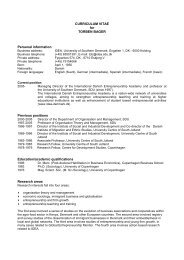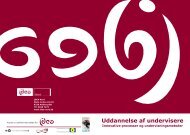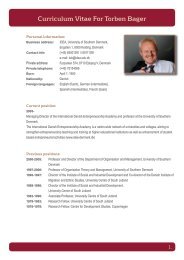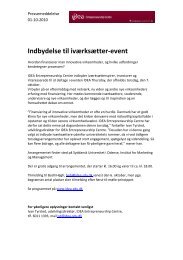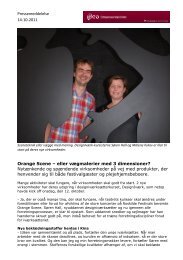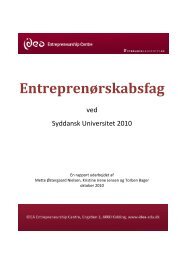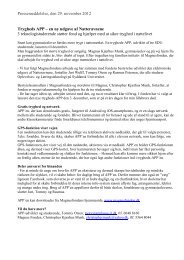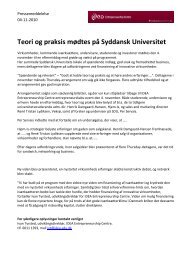Education, Training and Networking for Entrepreneurship in ...
Education, Training and Networking for Entrepreneurship in ...
Education, Training and Networking for Entrepreneurship in ...
You also want an ePaper? Increase the reach of your titles
YUMPU automatically turns print PDFs into web optimized ePapers that Google loves.
Table 8.4<br />
Vocation of adults, by their competency<br />
Denmark 2003-08<br />
Competent Less<br />
competent<br />
Non-entrepreneurs 64 % 92 %<br />
Entrepreneurs 36 % 8 %<br />
Sum 100 % 100 %<br />
N adults 7.122 10.715<br />
Table 8.5<br />
Vocation of adults, by their network<strong>in</strong>g<br />
Denmark 2003-08<br />
<strong>Network<strong>in</strong>g</strong><br />
Not<br />
network<strong>in</strong>g<br />
Non-entrepreneurs 71 % 90 %<br />
Entrepreneur 29 % 10 %<br />
Sum 100 % 100 %<br />
N adults 8.502 9.842<br />
Vocation is shaped by competency, <strong>in</strong> the manner<br />
that competent people are far more likely to<br />
be entrepreneurs than less competent people<br />
(hold<strong>in</strong>g other conditions constant). Vocation is<br />
also shaped by network<strong>in</strong>g, <strong>in</strong> the manner that<br />
network<strong>in</strong>g people are more likely to be entrepreneurs<br />
than non network<strong>in</strong>g people. <strong>Tra<strong>in</strong><strong>in</strong>g</strong><br />
seems to have a t<strong>in</strong>y effect on vocation. <strong>Education</strong><br />
affects vocation <strong>in</strong> the follow<strong>in</strong>g ways:<br />
people with medium or short higher education<br />
or with vocational education have less likelihood<br />
of becom<strong>in</strong>g entrepreneurs than people<br />
with long higher education. Also people with<br />
neither vocational nor higher education have<br />
less likelihood of becom<strong>in</strong>g entrepreneurs than<br />
people with higher education (control<strong>in</strong>g <strong>for</strong><br />
the other conditions).<br />
These effects are shown <strong>in</strong> Figure 8.2, which<br />
also shows the effects found <strong>in</strong> the preced<strong>in</strong>g<br />
chapter (Figure 7.2). A solid arrow denotes a<br />
positive effect, a dashed arrow shows a negative<br />
effect, <strong>and</strong> the thickness of an arrow symbolizes<br />
the magnitude of the effect.<br />
Vocation can thus be partly understood <strong>and</strong> expla<strong>in</strong>ed<br />
<strong>in</strong> terms of four factors: education,<br />
tra<strong>in</strong><strong>in</strong>g, competency <strong>and</strong> network<strong>in</strong>g. People<br />
with long higher education, with tra<strong>in</strong><strong>in</strong>g, with<br />
competency, <strong>and</strong> with a network are more likely<br />
than other people to be entrepreneurs.<br />
probability-value less than 0.0001 <strong>in</strong> a one-sided<br />
chi-square test).<br />
The above cross-tabulations show how vocation<br />
relates to each condition, while ignor<strong>in</strong>g<br />
the other conditions. This limitation will now be<br />
overcome by a more elaborate analysis.<br />
Hav<strong>in</strong>g studied people, as they may or may not<br />
be <strong>in</strong>volved <strong>in</strong> entrepreneurship, we now zoom<br />
<strong>in</strong> to focus on the entrepreneurs.<br />
Effects upon people’s vocation from their<br />
education, tra<strong>in</strong><strong>in</strong>g, competency <strong>and</strong><br />
network<strong>in</strong>g<br />
Now we address the further question, how is<br />
vocation affected by each condition, while hold<strong>in</strong>g<br />
the other conditions constant? The dist<strong>in</strong>ct<br />
effects are estimated by regression (Table 8.6 <strong>in</strong><br />
the appendix).<br />
56




